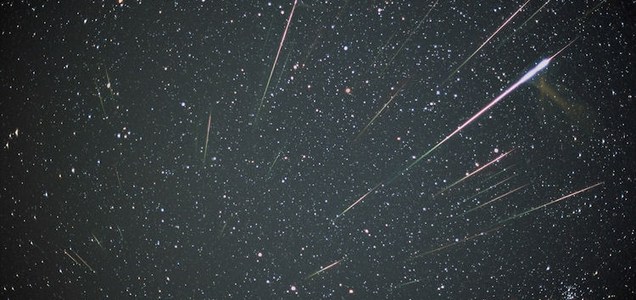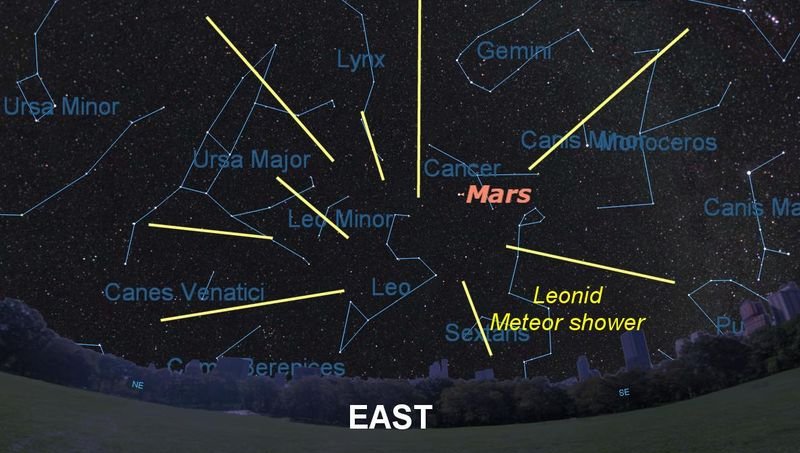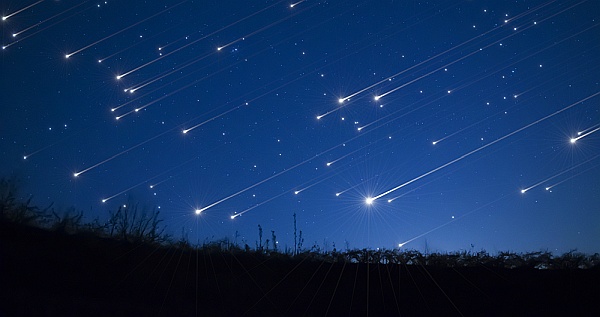This article was posted by CrystalWind.ca.
Leonid Meteor Shower
- Details

In mid-November, spectacular "shooting stars" will streak through the night sky as the Leonid meteor shower hits Earth once again. This annual meteor shower, which peaks overnight on Nov 17, is responsible for some of the most intense meteor storms in history. Sometimes, meteors fall at rates as high as 50,000 per hour.
These storms only happen rarely; viewers this year will still be treated to an hourly rate of 10 to 20 meteors, according to Sky and Telescope, on the peak date of Friday, Nov. 17. Our columnist Joe Rao tells you what to expect. The best time to look for will be before dawn Friday at 3 a.m. EST (0800 GMT), according to Jane Houston Jones of NASA's Jet Propulsion Laboratory. [Top 10 Leonid Meteor Shower Facts]
When to see them
In 2016, visibility was poor because bright light from the waning gibbous moon outshone some of the meteors. This year, however, visibility will be excellent because the new moon will take place on Nov. 18, providing a perfect view of the meteors, which will not be washed out by any lunar light.
The Leonid meteor shower peaks on the night of Friday, Nov. 17, and early the following morning. Skywatchers may be able to see some meteors on days just before and after the peak. The moon will only start to show its face briefly around sunset, meaning there will be excellent viewing conditions for watching the Leonids.

Where to see the Leonids
The Leonid meteor shower gets its name from the constellation Leo, where its meteors appear to originate. But you can look in just about any direction to enjoy the show, said NASA meteor expert Bill Cooke. If you directly face Leo, you may miss the meteors with longer tails.
Although the meteor shower might be a bit easier to see from the Northern Hemisphere, skywatchers in the Southern Hemisphere should be able to see the show as well. "They're not quite as good, but almost as good," said Cooke. "The Leonids are an OK shower from the Southern Hemisphere."

What causes the Leonids?
The Leonid meteor shower happens every year in November, when Earth's orbit crosses the orbit of Comet Tempel-Tuttle. The comet makes its way around the sun every 33.3 years, leaving a trail of dust rubble in its wake.
When Earth's orbit crosses this trail of debris, pieces of the comet fall toward the planet's surface. Drag, or air resistance, in Earth's atmosphere cause the comet's crumbs to heat up and ignite into burning balls of fire called meteors. [How Comets Cause Meteor Showers]
These comet crumbs are usually the size of a grain of sand or a pea, so they tend to burn up entirely before striking Earth's surface. Meteors that survive the whole journey to the ground are called meteorites. But the Leonid meteor shower likely won't deliver any meteorites.
What do you need to see them?
Meteors will be visible to the naked eye, so you won't need any special equipment to see them.
"Go outside, find a dark sky, lie flat on your back and look straight up," Cooke said, "and be prepared to spend a couple of hours outside."
Given that the meteors are fairly sparse and take place during a cold time of year, it is best to bundle up, relax
© CrystalWind.ca 2024. All content (articles, imagery, fair use) & design protected. Written permission required for copying. All rights reserved.
Join the Conversation Now! Comment Below! ![]()

Spirit Animal Totem Of The Day!
Crystal Of The Day!
Latest Articles
The Crystal Wind Oracle
Myth & Magic Card Deck!
Details Here!
NEW Expanded
Printed & Boxed!
Now with 58 cards!
CrystalWind.ca is free to use because of
donations from people like you.
Donate Now »

Unlock Your Light: Join Lightworkers Worldwide on CrystalWind.ca!
Articles: The Founders
Articles: Cosmic Neighbours
Articles: Galactic History
Follow Us!
Who is Online Now
We have 28950 guests and no members online
Featured This Month
Taurus Mythology
The Taurus Myth The Taurus myth is most often interpreted as the story of Z... Read more
The Time of No Time: Beltane!
Around the medicine wheel of life we go, from season to season (solstice to ... Read more
The Seven Chakras and their Meanings
If you could imagine chakras as circles of energy, flowing all the way throu... Read more
Bright Beltane Blessings!
The wheel turns to Beltane, also known as Mayday, marking the beginning of S... Read more
The Crystal Wind Oracle Card Deck
The Crystal Wind Oracle™ The Crystal Wind Oracle Myth & Magic Card D... Read more
Cartomancy - Fortune Telling Using Playing C…
Cartomancy is the act of divining using cards. Divining means to find out by... Read more
Sun in Taurus
Sun in Taurus April 21 through May 21 An Overview of Sun Sign Characteristi... Read more
Frogs Return Moon
Beaver – Chrysocolla - Blue Camas – Blue April 20 – May 20 The Frogs Retur... Read more










































